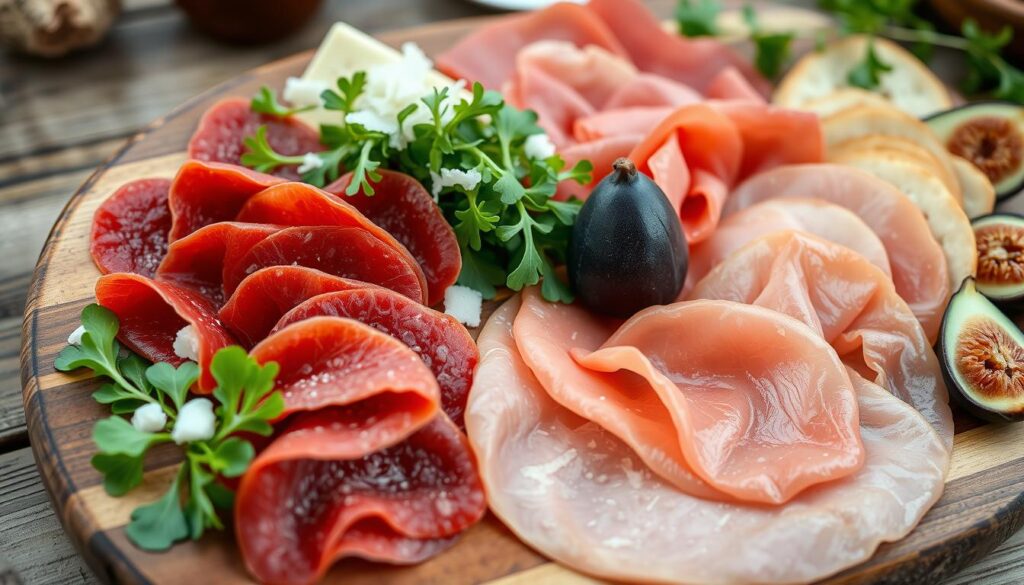The world of cured meats is vast and diverse, with a rich history spanning centuries across various cultures. Thinly sliced cured beef is known by different names like bresaola, basturma, and Bündnerfleisch. These meats are preserved through salt-curing, air-drying, and sometimes smoking. This process gives them distinctive flavors and textures enjoyed worldwide.
Bresaola is a key player in this tradition, coming from Italy’s Lombardy region. It’s made from lean eye of round beef, seasoned with garlic, black pepper, and juniper. After about three months of aging, it’s served thinly sliced as an antipasto. It’s also used in pizzas and sandwiches for extra flavor.
Cured meats like bresaola show centuries of culinary tradition. They are enjoyed in many ways across cultures. From the French saucisson sec to Spain’s famous Jamón Ibérico, each place has its own twist on curing and preserving meats. Exploring thinly sliced cured beef is a tasty journey through global cuisine.
Table of Contents
Understanding Beef Bresaola: The Italian Delicacy
Bresaola is a tasty air-dried and salted beef from Lombardy, Italy. It’s made from lean cuts, like the eye of round. It’s seasoned with local wines, black pepper, and juniper berries. This gives it a unique rosy-red color.
Origin and Traditional Production Methods
Bresaola comes from the Alpine region of Valtellina. Here, curing meats is an ancient art. The beef is salted and air-dried for up to three months. This makes the flavors rich and the meat tender.
Unique Characteristics of Bresaola
- Lean and low in fat, making it a healthier option for charcuterie enthusiasts
- Distinctive rosy-red color achieved through the curing process
- Delicate, velvety texture that melts in your mouth
- Subtle, aromatic flavors imparted by the local wines and spices used in curing
Nutritional Benefits and Health Aspects
Bresaola is not just tasty but also good for you. It’s low in fat and high in protein. Enjoy it on its own, with melons, or as a carpaccio. It’s a flavorful, guilt-free choice for anyone.
What is Thinly Sliced Cured Beef Called?
Thinly sliced cured beef has different names based on where it’s from and how it’s made. What is cured beef called? Here are some common types:
- Bresaola – An Italian delicacy made from lean beef that’s cured with salt and spices, then air-dried.
- Basturma or Pastirma – A Middle Eastern air-dried, cured meat specialty.
- Bündnerfleisch – A Swiss cured beef variety known for its distinct flavor and texture.
- Cecina – A traditional Spanish cured beef that’s thinly sliced and often served as an appetizer.
These cured beef products come from lean cuts of meat. They are cured with salt and spices, then air-dried. This process gives them a unique flavor and texture.
So, what is raw thin sliced meat called? Thinly sliced cured beef, like bresaola, basturma, Bündnerfleisch, and cecina, are tasty and special meats from around the world.
The Art of Curing Beef: From Ancient Times to Modern Day
Curing beef has been around for ages, used to keep meat fresh before refrigerators were invented. People used salt, spices, and sometimes sugar on the meat. Then, they dried it in the air to get rid of extra moisture.
Traditional Curing Techniques
Long ago, curing was done outside, using salt, air, and time. This careful method turned raw beef into tasty, long-lasting beef bresaola. It let our ancestors enjoy the meat’s rich flavor for a long time.
Modern Curing Methods
Now, making beef bresaola and other cured meats is done in controlled places with special tools. The basic steps are the same, but today’s methods use exact temperatures and humidity. This makes sure the meat is safe and tastes great every time.
Safety and Preservation Standards
Today’s beef bresaola and other cured meats must follow strict rules. Ingredients like sodium nitrite help keep bad bacteria away. This way, beef bresaola and other cured meats are safe to eat. You can find them in specialty stores, Italian markets, or fancy grocery stores.
Bresaola vs Prosciutto: Key Differences Explained
Both bresaola and prosciutto are famous Italian cured meats. But they differ in many ways. Bresaola comes from lean beef, usually the eye of round. Prosciutto, on the other hand, is made from pork leg.
This difference in meat makes bresaola darker red and leaner. Prosciutto has a pinkish color and a more marbled texture.
The curing process also differs. Bresaola is air-dried for months, which gives it a strong, beefy taste. Prosciutto, however, is cured for a longer time. This makes it sweeter and more pork-like.
Bresaola is often seen as a healthier choice because it has less fat. This makes it a favorite for those looking for a leaner option.
| Characteristic | Bresaola | Prosciutto |
|---|---|---|
| Meat Source | Beef, typically eye of round | Pork leg |
| Color | Darker red | Pinkish, more marbled |
| Texture | Leaner | More marbled |
| Curing Process | Air-dried for several months | Longer, more complex curing process |
| Flavor Profile | Intense, beefy | Sweeter, porkier |
| Healthier Option | Yes, due to lower fat content | No, higher in fat |
Whether you like the bold taste of bresaola or the traditional sweetness of prosciutto, both offer great flavors. They are perfect for exploring the world of Italian cured meats.

Popular Ways to Serve and Enjoy Bresaola
Bresaola is a tasty air-dried, salted beef from Northern Italy’s Valtellina valley. It’s great in both traditional Italian dishes and new recipes. Let’s look at how to enjoy this delicious cured meat.
Classic Italian Serving Suggestions
In Italy, bresaola is a favorite antipasto. It’s sliced thin and dressed with olive oil and lemon. This highlights its rich, slightly gamey taste. Another favorite is Bresaola Carpaccio, with arugula, Parmesan, and mushrooms.
Modern Culinary Applications
Bresaola is more than just an appetizer today. It’s great in salads, adding flavor to fresh greens. It’s also a tasty pizza topping. Thin slices in pasta dishes add savory notes.
Wine Pairing Recommendations
For wine, light to medium-bodied reds from Lombardy are perfect. Valpolicella or Chianti balance bresaola’s richness. It’s also great on charcuterie boards with other meats and cheeses.
Where to Buy Beef Bresaola and What to Look For
Looking for beef bresaola is a fun journey. You can find it in Italian markets, gourmet food stores, and some supermarkets. Online, you can also buy it from online retailers.
When you buy beef bresaola, check its color and texture. It should be a deep red and slightly shiny. The meat should feel firm but not dry. Stay away from packages that are too wet or show mold. Look for the PGI mark to know it’s made the traditional way in Italy.
| Where to Buy Beef Bresaola | What to Look For |
|---|---|
|
|
By focusing on these signs and buying from trusted places, you’ll get the best beef bresaola. Enjoy it on a charcuterie board, in a salad, or by itself.
Other Notable Cured Beef Varieties Around the World
Bresaola is a famous Italian cured beef, but there are many more to try. From the Swiss Alps to the Middle East, each place has its own way of making what is raw thin sliced meat called? or what is thin cut beef called? more delicious.
Bündnerfleisch from Switzerland
Bündnerfleisch comes from Switzerland’s Graubünden mountains. It’s similar to bresaola but is pressed during curing. This makes it denser and more even.
Basturma from the Middle East
Basturma is a Middle Eastern specialty. It’s cured beef that’s first salted, then coated in spices like fenugreek and garlic. After air-drying, it becomes a flavorful, thin what is raw thin sliced meat called? perfect for charcuterie.
American Dried Beef Varieties
In the U.S., what is thin cut beef called? is known as “chipped beef.” It’s dried beef used in creamed dishes or on toast. Though not as fancy as European meats, American chipped beef shows the creativity of home cooks.
These cured beefs from around the world highlight the rich culinary history and creativity in preserving beef. From Bündnerfleisch to Basturma and American chipped beef, each offers a special taste and texture to discover.
Creating the Perfect Bresaola Charcuterie Board
Elevate your charcuterie experience with bresaola, a delectable Italian cured beef. It’s perfect for any board, adding variety in flavors and textures. Pair it with cheeses, breads, and accompaniments for a stunning spread.
Begin with mild, creamy cheeses like mozzarella or burrata. They offer a neutral base for the bresaola’s bold flavors. Next, place slices of beef bresaola sandwich material alongside crusty bread or crackers. This lets guests create their own tasty bites.
- Include fresh, seasonal fruits like figs, melon, or grapes for sweetness and juiciness.
- Add pickled vegetables, such as olives or peppers, for a tangy crunch.
- Roasted nuts, like almonds or pistachios, add a satisfying texture.
- Drizzle extra virgin olive oil over the bresaola just before serving. It enhances its rich flavors.
For a more substantial option, let guests make their own beef bresaola sandwich. Provide fresh greens, such as arugula or baby spinach, and sliced baguettes or rolls. This way, they can craft their ideal bresaola sandwich.

By choosing the right ingredients and arranging them beautifully, you can create a standout popular meat for charcuterie board. Show off the exceptional flavor and versatility of bresaola. Impress your guests with this Italian-inspired culinary masterpiece.
Storage and Handling Tips for Cured Beef
Preserving the quality and flavor of cured beef, like beef bresaola, is crucial. Proper storage and handling are key. Whether you’re a seasoned connoisseur or new to cured meats, knowing the essential steps is vital. It ensures you enjoy this Italian delicacy to the fullest.
To keep your cured beef fresh and flavorful, follow these storage tips:
- Store unopened packages of beef bresaola in the refrigerator at a temperature between 35-40°F (1.6-4.4°C).
- Once opened, wrap the cured beef tightly in plastic wrap or store it in an airtight container to maintain its quality.
- Consume the cured beef within 5-7 days of opening for optimal freshness.
- For longer-term storage, beef bresaola can be frozen for up to 3 months, though this may affect the texture slightly.
When handling cured beef, use clean utensils. Avoid touching the meat directly to prevent contamination. This keeps your cured meat safe and of high quality.
| Curing Time | Weight Loss | Ideal Storage Temperature |
|---|---|---|
| 4-5 weeks for small cuts | 35-40% | 40-33°F |
| Several months for larger cuts | 35-40% | 40-33°F |
By following these storage and handling tips, you can ensure your beef bresaola and other cured beef products stay delicious. They will also maintain their exceptional flavor, texture, and safety for your enjoyment.
Health Considerations and Nutritional Profile
Beef bresaola is a lean protein from Italy. It’s a good choice for those wanting more protein. A 100-gram serving has about 26 grams of protein. But, it’s also high in sodium, with up to 3.5 grams of salt per serving.
Beef bresaola has important nutrients like iron and zinc. But, it should be eaten in small amounts, especially if you watch your sodium. Too much sodium can raise blood pressure and heart disease risks. So, enjoy bresaola in a balanced diet, but keep an eye on your sodium.
Protein Content and Benefits
- Beef bresaola is a lean protein source, containing about 26 grams of protein per 100-gram serving.
- Protein is essential for building and repairing tissues, maintaining muscle mass, and supporting overall health.
- Incorporating beef bresaola into your diet can help you meet your daily protein requirements and support your fitness and wellness goals.
Sodium Levels and Consumption Guidelines
- Cured meats like beef bresaola are typically high in sodium due to the curing process.
- A typical 100-gram serving of beef bresaola can contain up to 3.5 grams of salt.
- Excessive sodium intake has been linked to an increased risk of high blood pressure, heart disease, and other health issues.
- It’s important to consume beef bresaola in moderation, especially for those with health conditions that require a low-sodium diet.
Common Mistakes to Avoid When Serving Cured Beef
When serving bresaola, avoid common mistakes. One big error is slicing the meat too thick. This makes it tough and hard to chew. Slice the bresaola very thin, using a sharp knife or a meat slicer.
It’s also key to serve the beef at room temperature. This lets it fully develop its aroma and taste. Take the bresaola out of the fridge about 30 minutes before serving. This way, it reaches the perfect temperature.
Don’t pair the beef with strong flavors like very salty cheeses or overpowering sauces. Instead, choose simple pairings that enhance the meat’s natural taste.
When saying “bresaola,” stress the second syllable, like “breh-ZOW-lah.” Remember, bresaola is different from prosciutto or other cured meats. Each has its own unique taste and serving style. Knowing the differences helps you enjoy beef bresaola to the fullest.

